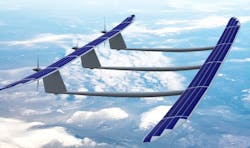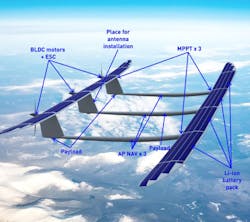Prototype Solar-Powered, High-Altitude UAV Undergoing Flight Tests
HAPS is happening. UAVOS Inc.’s HAPS (High Altitude Pseudo Satellite) aircraft, being developed with a flexible wing for high-altitude unmanned flight, will provide unique opportunities for both civilian and defense areas, as well as for security tasks.
Unmanned aerial vehicles (UAVs) powered by solar energy can serve for long continuous monitoring of the area of interest on the Earth's surface to get real-time information (see figure below). To meet the demands of telecommunication companies, HAPS can create a network of autonomous repeaters of radio and high-speed data signals over practically any territory. This includes the Northern regions during the summer, where the use of regular aircraft is highly problematic due to economic reasons, and weather conditions.
“By its very nature, this solution replaces the low-orbital space grouping and can provide services not available for conventional satellite systems,” explains Vadim Tarasov of UAVOS. “Such aircrafts can carry out long missions, for years operating in air currents over oceans, and territories with no airfield infrastructure, sparsely populated areas, sea borders, taking and relaying information for both civilian and military facilities.”
Functional capability of the advanced technology has been tested on the HAPS ApusDuo flight prototype. In general, the total flight time of UAVOS solar-powered test aircraft is more than 1000 hours. Test flights took place at an altitude of up to 65,617 feet (20,000 meters). Test flights confirmed that this type of control allows aircraft with a large wing elongation to fly in difficult weather conditions. The aircraft successfully copes with turbulence, actively changing the bend of the wing.
The flying model has a 46-ft. (14 meters) span of the wing and weighs 33 lb. (15 kg). The airframe of the unmanned vehicle is made of materials based on carbon fibers, which have very high strength, low weight, and are designed for long-term continuous operation.
What’s Behind the Power?
HAPS uses various sets of solar panels in different modifications of aircraft, namely, 1152 pieces and 1260 pieces. In both cases, single-crystal 125- × 125-mm solar cells were easily accessible, having efficiency of about 20%. The power, generated by solar panels at the time of solar radiation peak, is more than 3.5 kW (in middle latitudes). Currently, it’s possible to buy panels with significantly better efficiency, which are intended for future use.
Maximum voltage on the panels reaches 150 V, especially in the conditions of negative temperatures at high altitudes. Such voltage creates certain challenges in manufacturing of wing sections, since the carbon fiber, from which the wing is made, is the conductive material. Its slightest defect in the conditions of the discharged atmosphere can provoke an electric breakdown of the panels onto the wing structure, local overheating, and destruction.
To avoid such problems, various combinations of composite materials are used in the wing design. The sets of solar panels are divided into groups located in relatively equal planes of the wing, due to the uneven illumination of the wing in flight, and to obtain the maximum efficiency factor. The power circuit of the aircraft has two to four maximum-power-point-tracking (MPPT) converters of solar energy with the most up-to-date operation algorithms. Telemetry data obtained from them (power, voltage, current, and temperature), as well as from other numerous systems of the aircraft during the flight, are recorded at the ground control station.
The HAPS solar-powered, unmanned aircraft has functionality akin to spacecraft flying in LEOs.
The propulsion system consists of two or three BLDC motors, each rated at 2.5 kW. Total required power for a flight is about 0.9 kW. However, for flights at high altitudes, the required power to maintain a horizontal flight significantly increases and is already more than 2 kW, so it requires an excessively powerful motor. The onboard network of the aircraft is 48 V, with the motors controlled by a special regulator rated at 200 A, maximum.
Controllers and avionics are connected by a CAN data bus; all necessary information is always available for analysis and monitoring. The on-board 48-V Li-ion power battery system is distributed throughout the airframe, and is assembled from 18,650 elements. It’s similar to those used in laptops, since these elements have an acceptable price and one of the best watts-per-kilogram capacity. The battery modules are controlled by a common battery-management system (BMS) that registers all battery parameters, and controls the balancing and temperature operation of the batteries for the most efficient use of their capacity.
Eventually, the aircraft power systems will be controlled in automatic and semi-automatic modes from the autopilot modules of UAVOS design. Aircraft can be controlled from a conventional laptop running a Linux operating system.
During operation, onboard electronics don’t need constant participation of the operator. Instead, the system is designed so that in the absence of communication, the aircraft will follow a pre-loaded flight plan and the power system will be maintained automatically. It’s especially important for craft of this class, because the distance from the ground-control station can be hundreds of kilometers, and the only available control channel—a satellite—has limited capacity.
“I think, to date, none of the world's HAPS projects can perform long-term missions. However, that does not stop large corporations in the development of this direction of aviation,” says Tarasov. “This is due to the fact that the development of the high-capacity power-supply industry is now going through an investment boom and, probably, it will soon bear fruit not only for telephones and electric cars, but also for aircraft, including HAPS. It is quite obvious that the range of non-stop HAPS flights and their energy output is constantly increasing.”
Lead Up to HAPS
For more than 40 years, leading aircraft manufacturers have been working on the development of unmanned airplane-type aircraft capable of operating for a long time (from several days to several years) at altitudes of 60,000-100,000 feet (18,000-30,000 m). The objective of UAVOS’s project was to create the best solar-powered aircraft, which will bring to life the idea of non-stop flights and be able to fly for years.
During this time, the UAVOS team mastered the methods of calculating “solar” aircraft, propellers, aerodynamics, as well as UAV electrical systems. Special Grand Control Unit (GCU) software was created with a user-friendly interface for managing HAPS during long missions. The flow of information from the aircraft (more than 5,000 flight data units per second) is recorded, and all of the necessary parameters are displayed in a form convenient for operators’ perception to be later used for mathematical modeling and design improvements.
When designing this type of aircraft, weight perfection comes first. UAVOS had to design nearly every component from a scratch, even fasteners. Almost the entire structure is made of spread tow carbon fabric; a propeller blade of its own design has been developed and manufactured, as well as an original propeller pitch changing mechanism. All components were tested in freezing and vacuum chambers.
What Are the Results So Far?
At present, the batteries do not allow the HAPS to be in the stratosphere all day long (they use batteries with energy density of 113 Wh/lb. (260 Wh/kg). They’re confined to descend to heights with strong winds and 22,966-26,247 feet (7000-8000 m) of civil aviation routes at night. Scheduling of flights in the constantly changing meteorological situation, reconciliation of air traffic, changing of echelons, and the mission area require intensive work from a whole group of specialists, as well as the cooperation of air-traffic-control services. In such conditions, they’re confined to plan the flight path for several days ahead, and sometimes even weeks.
In project Apus, they were able to confirm the possibility of scaling the aircraft, violating the law of increasing the mass (the square-cube law). The weight of their apparatus doesn’t grow in a cube, but closer to a quadratic dependence on the span. This became possible due to the innovative aerodynamic layout of the aircraft and the control system. Their aircraft's wings are flexible, not having a massive spar, as well as stressed skin.
Since the start of the project, all new ideas, control algorithms, and components have been tested on scaled-down prototypes before being implemented on a full-scale aircraft. Test flights were conducted in diverse weather conditions. Thus, they have accumulated statistics and fairly quickly introduced all of the innovations in the aircraft at a stage of manufacturing.
In test flights, they were surprised by the rather accurate correspondence of the actual weather conditions and weather conditions predicted by the mathematical weather model provided by weather sites.
As of today, the use of this type of HAPS is associated with serious operational limitations. Aircraft designed for high-altitude flights usually have very low true airspeed (TAS) near ground, which imposes wind restrictions for take-off and landing, as well as the barrage requirements in a given area during strong winds. Fortunately, the average wind at the altitudes above 42,651 feet (13,000 m) is relatively weak, which makes it possible to carry out long missions in designated areas.
The scheme with the wing of ultra-high aspect ratio made it possible to compromise between airspeed and energy consumption due to high aerodynamic quality, which made it possible to expand the applicability boundaries. The ratio of the weight of modern batteries to the design of the aircraft reaches 1:1. Therefore, for the development of this technology, the key element is batteries with high volumetric efficiency.
Today, none of the world's projects can perform long missions in the winter. However, this doesn’t stop large corporations in the development of this direction of aviation. It’s obvious that with the advent of available batteries with a gravimetric energy density battery of 250 Wh/lb. (550 Wh/kg), year-round HAPS flights at altitudes of more than 42,651 feet (13,000 m), and in latitudes up to 10th will become a reality (several companies have announced market availability of such batteries in 2018). And with the advent of batteries with higher volumetric efficiency, film solar panels with greater efficiency and more sophisticated electronics, it will be possible to fly in latitudes above the 30th.


